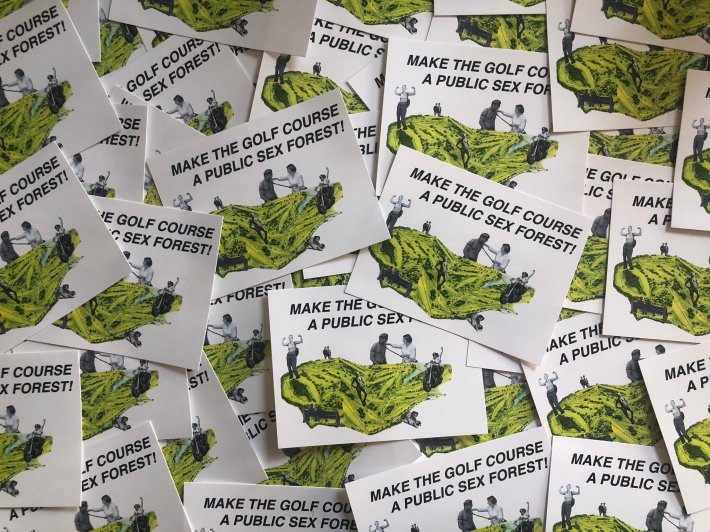There’s a manifesto going around right now, and it’s pretty radical.
“Make the golf course a public sex forest?” it opens. “An idea so obvious that it hardly feels necessary to explain further.”
Maybe not, but... let’s explain.
A few years ago, the city of Minneapolis considered closing the Hiawatha Golf Course and redesigning the space as an open park. The pitch was not well received, however, as the neighborhood erupted with a sea of "Save Hiawatha Golf Course" yard signs.
That movement inspired another: What if the area was transformed into an erotic playground, where visitors could delight in queer sex—and maybe enjoy a healthy snack?
“The sex forest will be for fags and faeries, dykes and sissies, e-girls and femboys, criminals and normies,” the manifesto states. “No single group will be in charge of the sex forest, but long-standing kink and leather organizations will collaborate with loose crews of anarcha-feminists to ensure that dungeon-monitors/pleasure lifeguards are on hand… You’ll recognize the pleasure lifeguards by their matching black assless chaps.”
So, why a sex forest? In our quarantine era, why can’t people just shack up at home? Can’t people just “get a room” at a nice sex hotel?
“There are so many reasons,” says photographer/filmmaker Lyn Corelle, who manages the Twitter account Make The Golf Course a Public Sex Forest (@Sex_Forest). “Many people don’t have a good place to have sex, whether because of roommates or families. Others live with partners but are non-monogamous. A sex forest would be a good place to meet people looking for the same sorts of sex as you. It certainly would beat the bars and the apps. Others just might prefer having sex outside, as God intended.”
Corelle and their friends first printed out yard signs, which sold out at the Autonomous Zine Fest in early June. Next were stickers, which quickly sold out as well. (Proceeds from merch sales go to Southside Food Share; Corelle estimates they've raised about $1,000 total for the cause.)

Corelle is quick to point out that the Twin Cities’ has had a not-so underground history of public hotspots for decades.
“In the '80s and '90s these spaces were shut down across the country, ostensibly in the name of combating AIDS, but in reality to facilitate the gentrification of neighborhoods like downtown Minneapolis,” they explain. “Now that most of the country--or at least most of Minneapolis--has to at least pretend to tolerate queerness, it seems like a good time to rebuild the cruising ethos.”
The manifesto maps out more of that history. “The beach at East River Flats Park, south of the Franklin Avenue Bridge, was likely the most active cruising ground in the city. In 1981, the city spent $176,000 on an access ramp down to the park, ostensibly to facilitate trash collection, but in reality to allow police to drive down and attack queers having sex.”
As for the Hiawatha Golf Course, it's been open since 1934 and features 140 acres of greenery, 18 holes, a driving range, and a clubhouse. Over the years, the course has seen some highs (for many years it was one of the only clubs in the cities where Black athletes could play) and some lows (the area has seen massive floods requiring millions to repair).
In 2017, a separate group, Hiawatha Food Forest, proposed turning the area back to its former state, which included swampy wetlands, and populating it with edible plants native to Minnesota. Corelle and the Sex Park friends like this idea, too.
“People have been advocating for a food forest at Hiawatha Lake for years. We think that would be awesome,” says Corelle, “and so we figured a mixed-use sex forest/food forest would be a natural combination. The idea has got us thinking about the best post-coital treats that could grow in Minneapolis. Cherry tomatoes and plums?”
It’s also worth pointing out that golf courses are pretty shitty for the planet.
“The fact remains that golf courses waste massive amounts of water and are terrible for the environment in many other ways,” says Corelle. “This is especially true for the Hiawatha Golf Course, as the excessive pumping required to drain the course makes Lake Hiawatha the most polluted lake in the city.”
So what is the future of the Hiawatha Golf Course? For now, it looks like it’s here to stay. Just this July, the Minneapolis Park Board rejected a $43 million redesign plan, and the debate continues over preserving local history and the realities of sustaining a course built on a floodplain. Regardless of what happens, the Sex Forest gang will continue to plant seeds that there’s a time and place for public sex. At the very least, their campaign encourages folks to reconsider how public space is used.
“The future is unwritten!” says Corelle. “To be honest, we have been blown away by the response to the manifesto and yard signs—not just locally but across the country and the world. So we definitely intend to keep ratcheting open the discussion around sex and sociality.”
A few weeks ago, the Sex Forest peeps put out a call for essays, creative writing, and erotica to be issued as a zine, book, or some other DIY format yet to be determined. The collection, tentatively named Make The Golf Course a Public Sex Forest: Dispatches from a Sluttier Future, is taking submissions at publicsexforest@gmail.com.
Even if the golf course never becomes a Sex Forest, the campaign will hopefully yield some interesting smut.








